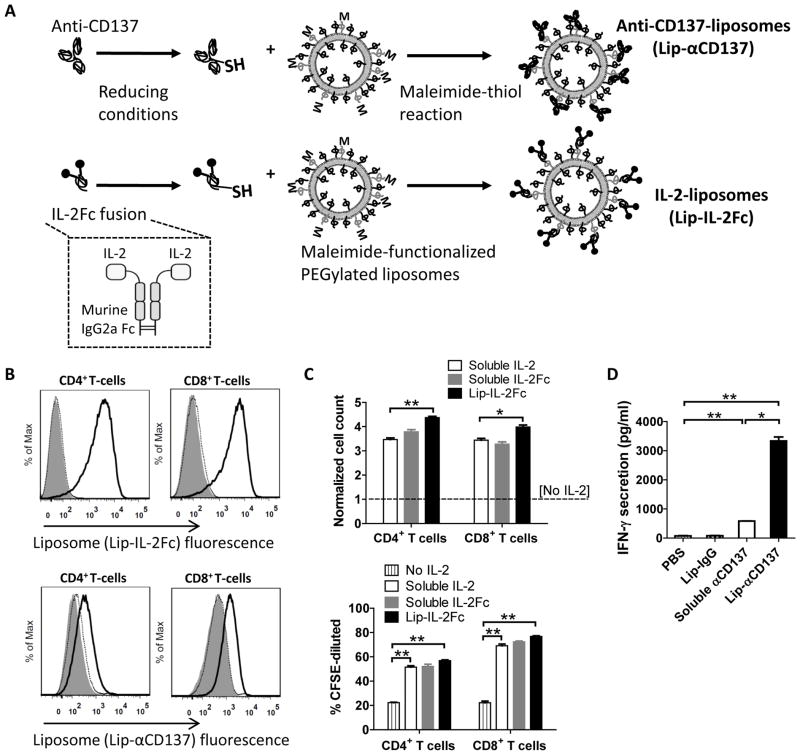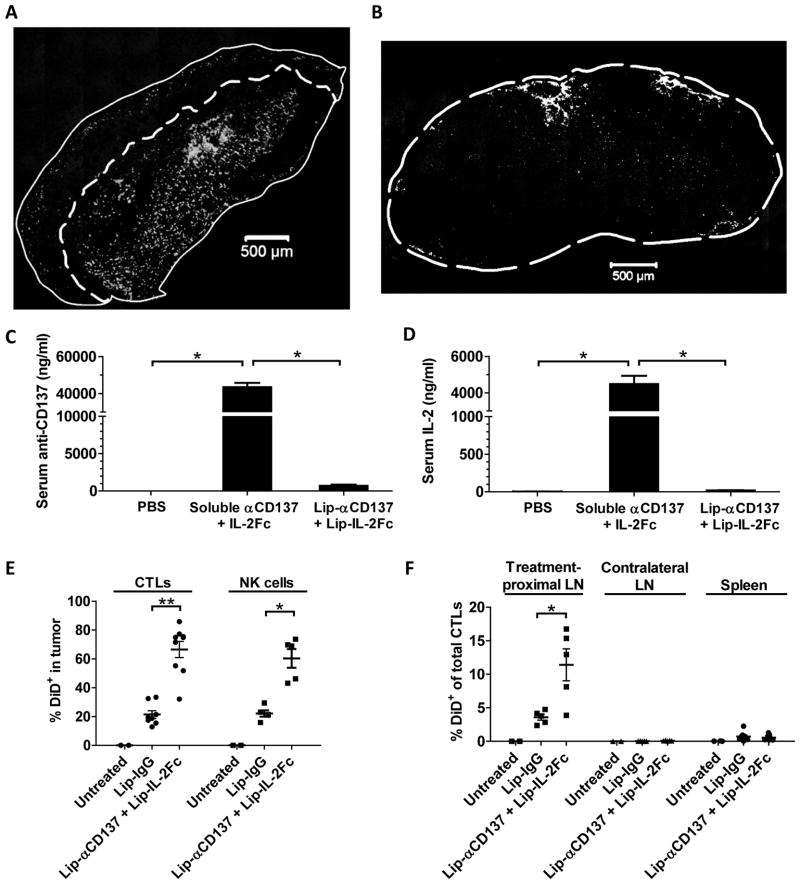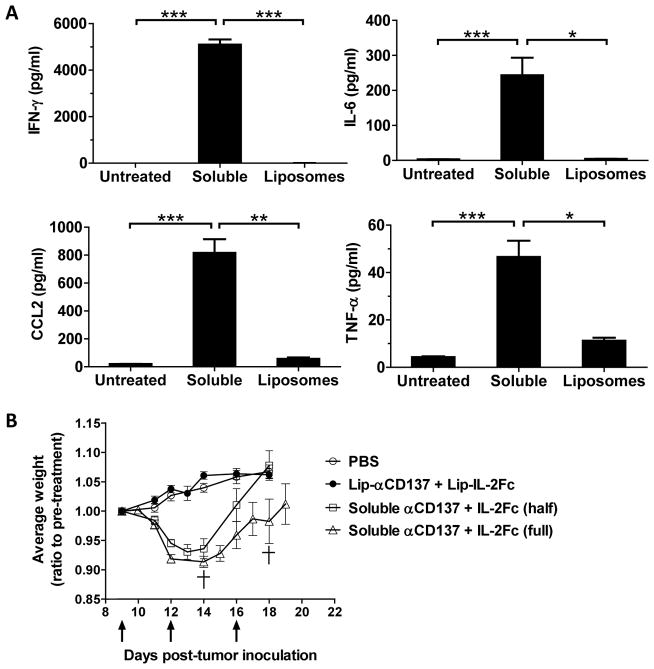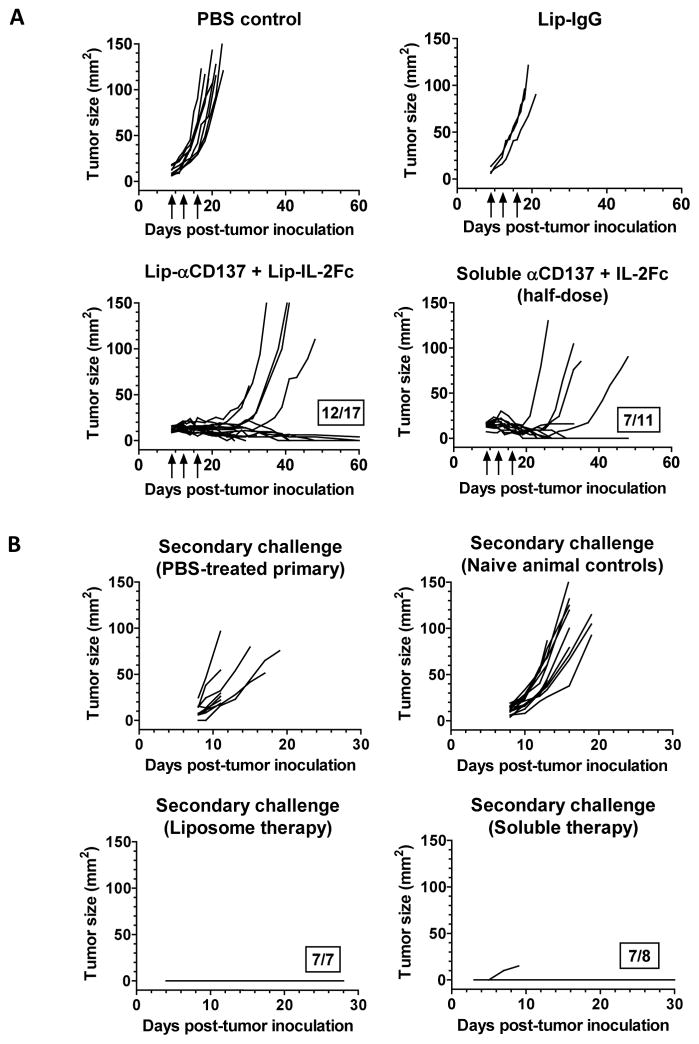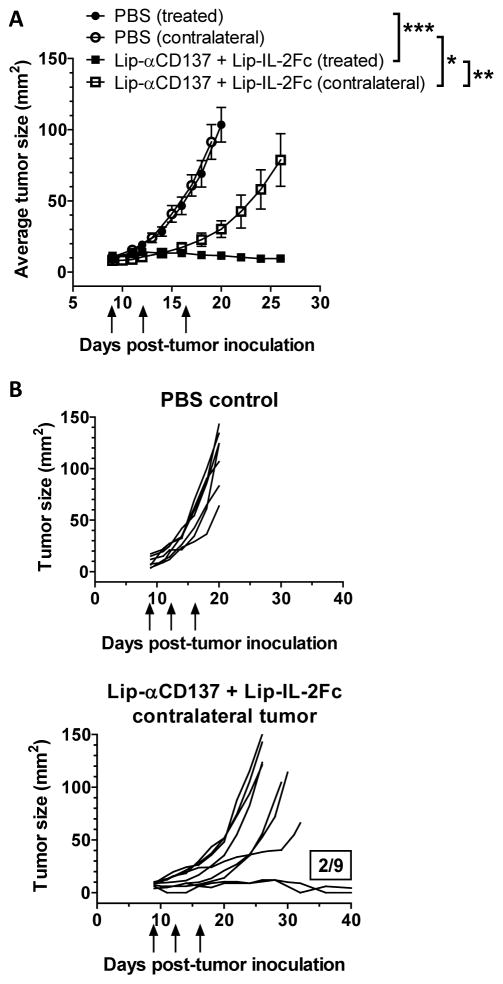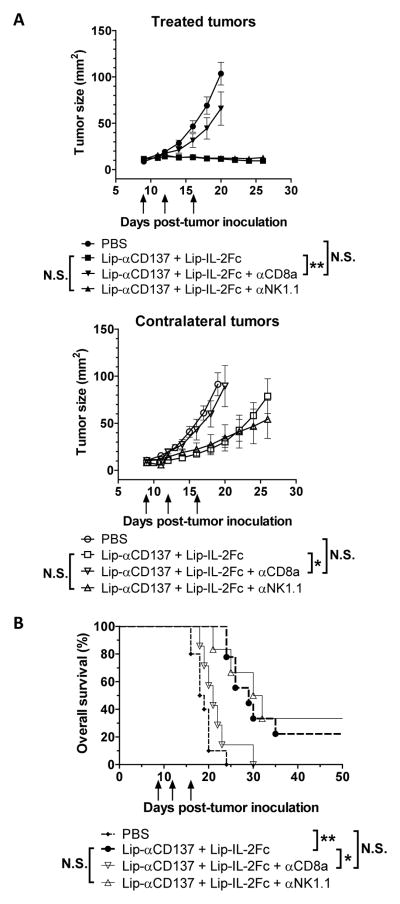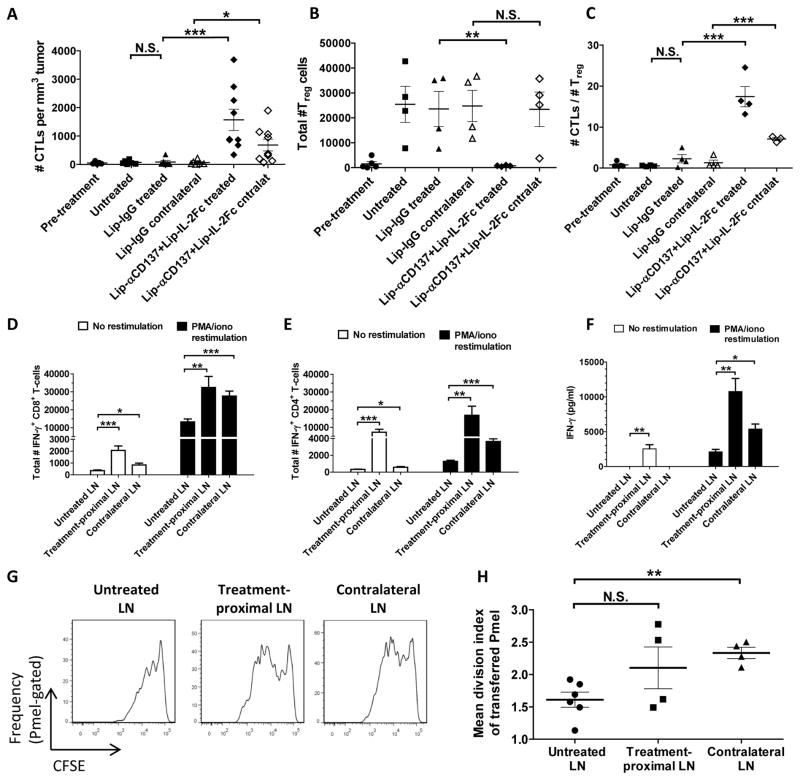Abstract
Immunostimulatory agonists such as anti-CD137 and interleukin-2 (IL-2) have elicited potent anti-tumor immune responses in preclinical studies, but their clinical use is limited by inflammatory toxicities that result upon systemic administration. We hypothesized that by rigorously restricting the biodistribution of immunotherapeutic agents to a locally accessible lesion and draining lymph node(s), effective local and systemic anti-tumor immunity could be achieved in the absence of systemic toxicity. We anchored anti-CD137 and an engineered IL-2Fc fusion protein to the surfaces of PEGylated liposomes, whose physical size permitted dissemination in the tumor parenchyma and tumor-draining lymph nodes but blocked entry into the systemic circulation following intratumoral injection. In the B16F10 melanoma model, intratumoral liposome-coupled anti-CD137 + IL-2Fc therapy cured a majority of established primary tumors, while avoiding the lethal inflammatory toxicities caused by equivalent intratumoral doses of soluble immunotherapy. Immuno-liposome therapy induced protective anti-tumor memory and elicited systemic anti-tumor immunity that significantly inhibited the growth of simultaneously-established distal tumors. Tumor inhibition was CD8+ T-cell-dependent and was associated with increased CD8+ T-cell infiltration in both treated and distal tumors, enhanced activation of tumor-antigen-specific T-cells in draining lymph nodes, and a reduction in regulatory T-cells in treated tumors. These data suggest that local nanoparticle-anchored delivery of immuno-agonists represents a promising strategy to improve the therapeutic window and clinical applicability of highly potent but otherwise intolerable regimens of cancer immunotherapy.
Keywords: Anti-CD137, IL-2, liposome delivery, anti-tumor immunity, localized biodistribution
Introduction
Immunostimulatory antibodies and cytokines elicit potent anti-tumor immunity in a variety of tumor models, often via the activation of cytotoxic T-lymphocyte (CTL) and natural killer (NK) cell responses. Interleukin-2 (IL-2) stimulates the proliferation and effector functions of both CTLs and NK cells, and has been approved for the treatment of advanced metastatic melanoma and renal cell carcinoma (1–3). Similarly, agonistic antibodies against the costimulatory receptor CD137 (4-1BB) expressed on the surface of activated T-cells, NK cells, and dendritic cells, potently inhibit tumor progression in preclinical mouse models and have begun testing in clinical trials (4–10). The priming of a CTL-mediated immune response is particularly attractive as it has the potential to target and eradicate recurrences or metastases in a tumor-specific manner (11–14). Nevertheless, the clinical use of immunomodulatory agonists has been hindered by dose-limiting inflammatory toxicities that often accompany systemic administration (15, 16). Intravenous anti-CD137 elicits liver inflammatory damage, systemic inflammatory cytokine release, hematologic abnormalities, and disruptions in lymphocyte trafficking (4, 17, 18), while IL-2 therapy is accompanied by potentially lethal side effects such as capillary leak syndrome (19, 20). Although local injections may reduce the systemic exposure to potent immuno-agonists (21–24), such approaches remain inherently dose-limited, as soluble proteins rapidly reach the systemic circulation following intra- or peri-tumoral injection, via lymphatic drainage or direct entry into leaky tumor vasculature (25–30).
We recently developed a strategy to block systemic side effects from anti-CD40 and CpG oligonucleotides, two potent anti-tumor therapeutics, by locally administering these immuno-agonists conjugated to liposomal nanoparticles (25). Intratumorally (i.t.)-injected anti-CD40/CpG-liposomes dispersed throughout the tumor matrix and entered local lymphatics but were restricted from penetrating tumor vasculature or reaching the systemic circulation, thus prolonging the local immunotherapy exposure while eliminating symptoms of liver toxicity and systemic cytokine storms observed following soluble i.t. therapy. Although i.t. anti-CD40/CpG-liposomes delayed the progression of established tumors in the poorly immunogenic B16F10 melanoma model (25), this treatment combination failed to induce complete/durable tumor rejections. We hypothesized that anti-CD137 and IL-2 co-delivered via this liposome-anchored approach would synergistically activate tumor-specific T-lymphocytes in the tumor and tumor-draining lymph nodes (TDLNs), thereby priming effective local immune responses and the systemic dissemination of CTLs capable of targeting distal untreated lesions (31, 32).
Using the murine B16F10 model, we show here that local therapy with anti-CD137-liposomes and IL-2-liposomes leads to potent anti-tumor activity with no evidence for systemic toxicity, unlike i.t. soluble anti-CD137+IL-2 treatment. Importantly, control of local tumor progression by i.t. liposome therapy was accompanied by systemic anti-tumor immune responses, which restrained the growth of simultaneously established distant tumors. Thus, liposomal delivery enables aggressive local treatment with high doses of immunotherapeutic agents, promoting a systemic immune response without systemic toxicity.
Materials and Methods
Materials
Anti-CD137 (clone LOB12.3), anti-CD8a (clone 2.43), anti-NK1.1 (clone PK136), and rat IgG isotype control antibodies were from BioXCell (West Lebanon, NH). Dioleoylphosphocholine (DOPC), polyethylene glycol (PEG)2000-distearoylphosphoethanolamine (DSPE), maleimide-PEG2000-DSPE (Avanti Polar Lipids, Alabaster, AL), and lipid tracer DiD (Invitrogen, Grand Island, NY) were used as received. Fluorescent antibodies against mouse CD45, CD3, CD8a, CD4, NK1.1, Thy1.1, IFN-γ, and Foxp3 were from eBioscience (San Diego, CA). The Cytometric Bead Array Mouse Inflammation Kit was from BD Biosciences (San Jose, CA).
Preparation of anti-CD137-liposomes and IL-2Fc-liposomes
IL-2Fc was prepared as a bivalent fusion of the N-terminus of murine IL-2 to the heavy chain of murine IgG2a (Fig. 1A, Gai and Wittrup, manuscript in preparation) and expressed in HEK293 Freestyle cells (Invitrogen). Anti-CD137-coupled liposomes (Lip-αCD137) and IL-2Fc-coupled liposomes (Lip-IL-2Fc) were prepared as previously described (25): briefly, liposomes were first prepared with a composition of cholesterol/DOPC/PEG-DSPE/maleimide-PEG-DSPE at 35/60/2.5/2.5 or 35/62.5/0/2.5 mol% for Lip-αCD137 or Lip-IL-2Fc, respectively, and with 0.1 mol% of the fluorescent dye DiD for labeling. Anti-CD137 and IL-2Fc were treated with 1.8mM dithiothreitol to expose hinge region thiols, then mixed with liposomes for covalent maleimide-thiol conjugation. Conjugated liposomes were washed with PBS to remove unbound protein. The quantification of liposome-bound anti-CD137 or IL-2Fc was performed by ELISA following solubilization of liposomes in 0.5% Tween 20 buffer. Endotoxin levels in Lip-αCD137 and Lip-IL-2Fc were found to be <1 EU/mg of liposomes by LAL assay (Pierce, Rockford, IL).
Figure 1.
Anti-CD137-liposomes (Lip-αCD137) and IL-2Fc-liposomes (Lip-IL-2Fc) are bioactive for T-cell binding and stimulation in vitro. A. Schematic of immuno-liposome preparation. B. Flow cytometry histograms of activated CD4+ and CD8+ T-cells after 2h of incubation in vitro with fluorescently-labeled Lip-IL-2Fc or Lip-αCD137 (solid unfilled), unconjugated liposomes (dashed unfilled), or no liposomes (grey filled). C. In vitro T-cell proliferation after 48h incubation with Lip-IL-2Fc, IL-2Fc, or IL-2 as measured by cell counts (normalized to unstimulated cells) or CFSE dilution. *p=0.002, **p<0.0001. D. IFN-γ production by polyclonal T-cells stimulated by Lip-αCD137, isotype control liposomes, or soluble anti-CD137 after 24h. *p=0.0002, **p<0.0001.
In vitro bioactivity of Lip-αCD137 and Lip-IL-2Fc
C57Bl/6 splenocytes were polyclonally activated for 2 days, CFSE-labeled, then re-plated with 20 ng/ml IL-2 (Peprotech), IL-2Fc, or Lip-IL-2Fc (equivalent molar doses). Specific binding of fluorescent IL-2Fc-liposomes to T-cells was assessed by flow cytometry after 2h, while total live cell counts and CFSE dilution were analyzed after 48h. In parallel, activated splenocytes were cultured with IL-2 for days 2–4, followed by 5 μg/ml soluble anti-CD137 or Lip-αCD137. Binding of fluorescent anti-CD137-liposomes was analyzed after 2h, and culture supernatants were collected after 24h for the measurement of IFN-γ by ELISA.
In vivo tumor therapy
Mice were handled in the USDA-inspected MIT Animal Facility following federal, state, and local guidelines. 6–8 week-old female C57Bl/6 mice (Jackson Laboratory, Bar Harbor, ME) were inoculated subcutaneously with 5×104 B16F10 cells (authenticated from American Type Culture Collection, cultured <6 months before use) on a single flank or both hind flanks. Tumor area was calculated as the product of 2 measured orthogonal diameters (D1×D2). Mice were treated on one flank with intra-tumoral injections on days 9/12/16 unless otherwise indicated, using PBS, soluble anti-CD137+IL-2Fc, Lip-αCD137+Lip-IL-2Fc, or rat IgG isotype-liposomes (Lip-IgG), at an equivalence of 100 μg antibody + 20 μg IL-2 per dose unless otherwise indicated. For in vivo depletion, 400 μg/dose of anti-CD8a or anti-NK1.1 were injected intraperitoneally on days 7/12/16. To assess establishment of tumor-specific memory responses, single-tumor-bearing mice were treated as described above, and at 4 or 8 weeks post-primary inoculation, a secondary challenge of 5×104 B16F10 cells was inoculated into the opposite hind flank and monitored without additional therapy. Weights of treated mice were measured daily as an indicator of body condition and systemic toxicity. Serum levels of anti-CD137 or IL-2 were quantified by ELISA, and serum cytokines were measured by Cytometric Bead Array (BD Biosciences). For additional tumor models, Balb/c mice (Jackson Laboratory) or C57Bl/6 mice were inoculated s.c. on a single flank with 2×106 A20 cells (ATCC, cultured <6 months before use) or 3×105 TC-1 cells (authenticated and received from Dr. T.C. Wu, Johns Hopkins University), respectively, then treated on days 7/9/11 post-inoculation with intratumoral injections of PBS or Lip-αCD137+Lip-IL-2Fc (75 μg antibody + 15 μg IL-2 per dose).
Flow cytometry and histological analysis
Mice with B16F10 tumors on both hind flanks were injected with DiD-labeled Lip-IgG, Lip-αCD137+Lip-IL-2Fc, or saline on one flank only. The treated and contralateral tumors, proximal and contralateral TDLNs, and spleens were harvested and dissociated into single-cell suspensions for flow cytometry analysis on a FACSCanto II (BD Biosciecnes). Regulatory T-cell (Treg) levels were quantified by intracellular Foxp3 staining. For histological analysis, treated tumors or tumor-draining lymph nodes were snap-frozen for cryosection. Tissue sections were imaged on a Zeiss LSM 510 confocal microscope for the presence of DiD-labeled liposomes, with or without CD3/B220 co-staining. For pharmacokinetic analysis, treated tumors were harvested at indicated timepoints and digested in Tissue Protein Extraction Reagent + Halt Protease Inhibitor Cocktail (Pierce); supernatants from homogenized tisuses were then analyzed by fluorescence for DiD concentrations and by ELISA for concentrations of anti-CD137 and IL-2Fc.
Ex vivo T-cell activation
IFN-γ production by lymphocytes was assessed by placing single-cell suspensions from TDLNs in culture for 12h, with or without PMA (50 ng/ml) + ionomycin (1 μM) re-stimulation, followed by addition of brefeldin A for 5h. Intracellular IFN-γ was analyzed by flow cytometry, while ex vivo culture supernatants were analyzed by ELISA for secreted cytokine.
Adoptive transfer of B16 tumor-specific CD8+ T-cells
Naïve CD8+ T-cells expressing a transgenic TCR specific for the B16 melanoma self-antigen gp100 (33) were isolated from female Thy1.1+ Pmel-1 mice (Jackson Laboratory) using a CD8 Negative Isolation Kit (Stemcell Technologies, Vancouver, Canada), CFSE-labeled, then adoptively transferred (2×106 cells/mouse) into B16F10 tumor-bearing mice on day 7 post-tumor inoculation. Mice were treated with i.t. liposome therapy as previously described, and the treated and contralateral TDLNs were excised on day 14 for flow cytometry analysis of CFSE dilution in CD8+Thy1.1+ Pmel cells.
Statistical analysis
Data are shown as mean ± SEM. Average tumor growths were compared using two-way ANOVA, and Kaplan-Meier survival curves were compared by log-rank test. For all other data, comparisons of two experimental groups were analyzed by two-tailed unpaired t-tests. Statistical analysis was performed using GraphPad Prism software.
Results
Liposome-anchored anti-CD137 and IL-2Fc retain potent bioactivity
We first prepared liposome-anchored immunotherapeutics by conjugation of monoclonal anti-CD137 or an engineered murine IL-2Fc fusion protein (Gai and Wittrup, manuscript in preparation) to the surfaces of PEGylated liposomes (Fig. 1A). Reduced disulfides of the Fc hinge region were linked to maleimide-terminated phospholipids on the liposomes, yielding 130±10 μg of conjugated anti-CD137 or 53±7 μg of conjugated IL-2 (cytokine equivalence) per mg liposomes. Anti-CD137-coupled liposomes (Lip-αCD137) and IL-2Fc-coupled liposomes (Lip-IL-2Fc) were then size-extruded by membrane filtration to a mean diameter of 160±10 nm prior to use. Liposome-anchored IL-2Fc and αCD137 demonstrated specific binding to activated murine CD4+ and CD8+ T-cells in vitro (Fig. 1B), and retained T-cell stimulatory activity: CD4+ and CD8+ T-cells showed similar levels of proliferation in response to equivalent doses of soluble IL-2, soluble IL-2Fc, or Lip-IL-2Fc (Fig. 1C), while Lip-αCD137 was ~6-fold more potent than soluble αCD137 in inducing IFN-γ secretion from activated T-cells (Fig. 1D).
Intratumorally-injected Lip-αCD137+Lip-IL-2Fc therapy is locally retained and minimizes systemic exposure, preventing lethal systemic inflammatory toxicity
Since anti-CD137 and IL-2 elicit significant inflammatory toxicity upon systemic administration (17–19), we examined whether nanoparticle anchoring would enable local retention of these agents without systemic dissemination following intratumoral injections, in order to minimize systemic toxicity. Subcutaneous B16F10 tumors were injected i.t. with fluorescently-labeled Lip-αCD137 (100 μg antibody) and Lip-IL-2Fc (20 μg IL-2), on day 10 post-tumor inoculation. Fig. 2A shows representative histology 24h after injection, demonstrating the presence of liposomes throughout the tumor. Fluorescence measurements from homogenized tumor tissues showed that liposomes persisted at the treated tumor for ~96h post-injection (Supplementary Fig. S1A), while anti-CD137 and IL-2 were detectable up to 48h post-liposome injection (Supplementary Fig. S1B). Histological sections of TDLNs taken at 24h post-injection showed liposome accumulation primarily in the subcapsular sinuses, consistent with direct lymphatic drainage (Fig. 2B and Supplementary Fig. S2).
Figure 2.
Anti-CD137 and IL-2Fc immuno-liposomes are locally confined following intratumoral administration, minimizing systemic exposure. Established s.c. B16F10 tumors were injected i.t. with PBS, soluble anti-CD137 (100 μg) + IL-2Fc (20 μg IL-2), or equivalent doses of Lip-αCD137+Lip-IL-2Fc. A–B. Representative cryosections of a B16F10 tumor (A, dashed line indicates tumor boundary) and the TDLN (B), 24h post-injection of fluorescently-labeled immuno-liposomes (white). Scale bars 500 μm. C–D. Serum levels of anti-CD137 (C) and IL-2Fc (D) were analyzed 18h post-injection. *p<0.0001. E. Mice (n=5–9) received 2 i.t. doses of control Lip-IgG or Lip-αCD137+Lip-IL-2Fc on days 9 and 12 post-tumor inoculation, and tumors were analyzed by flow cytometry on day 14 for the percentage of DiD+ (liposome+) cells among CTLs or NK cells. *p=0.0005, **p<0.0001. F. Mice (n=5–9) were treated i.t. as in part (E) and the proximal TDLNs, contralateral LNs, and spleens were analyzed on day 14; *p=0.01.
In parallel, we measured serum levels of αCD137 and IL-2Fc 18h following a single i.t. dose of either liposome-coupled or soluble therapy. In contrast to soluble anti-CD137+IL-2Fc, i.t. liposome therapy resulted in minimal detectable levels of either agonist in the blood (Fig. 2C–D), confirming the ability of immuno-liposomes to physically restrict these locally-injected therapeutics. Flow cytometry analysis on day 14 following i.t. treatment of B16F10 tumors on days 9 and 12 showed that ~65% of tumor-infiltrating CD8+ T-cells and NK cells were labeled with immuno-liposomes, while isotype control liposomes (Lip-IgG) showed substantially lower nonspecific binding (Fig. 2E). Immuno-liposomes also bound to 5–15% of CD8+ T-cells in the proximal TDLNs, but were not detectable in spleens or distal LNs following intratumoral injections (Fig. 2F), confirming that lymphatic drainage of liposomes was confined to the treatment-proximal LN.
We next tested whether the dramatic reduction in systemic exposure achieved by liposome-anchored delivery impacted the systemic toxicity of αCD137+IL-2Fc therapy. Soluble i.t. doses of αCD137+IL-2Fc (days 9/12/16) induced significant elevations in serum levels of inflammatory cytokines (Fig. 3A) and rapid weight loss (Fig. 3B), accompanied by shivering, sluggish mobility, and other symptoms consistent with the measured systemic cytokine storm; these side effects were fatal in 2/8 soluble-treated animals (Fig. 3B). Mice treated with half-doses of soluble therapy (50 μg αCD137 + 10 μg IL-2Fc per dose) experienced comparable weight loss and fever-like symptoms, although without lethality (Fig. 3B). In contrast, full doses of i.t. Lip-αCD137+Lip-IL-2Fc elicited only minimal increases in systemic cytokines compared to PBS-treated mice, at either 1, 2, 3, or 5 days after the start of therapy (Fig. 3A and data not shown). Furthermore, i.t. liposome-treated mice did not exhibit weight loss or other physiologic symptoms of systemic cytokine release (Fig. 3B). Interestingly, intravenous administration of Lip-αCD137+Lip-IL-2Fc induced intermediate systemic inflammation (Supplementary Fig. S3), indicating that liposome-mediated elimination of toxicity was dependent on the restricted biodistribution of liposomes at the treated tumor and TDLNs. Thus, local liposome treatment enabled the safe administration of an otherwise intolerable dose of this immunostimulatory therapy.
Figure 3.
Immuno-liposome delivery of anti-CD137 and IL-2Fc prevents lethal systemic inflammatory toxicity. A. Mice (n=4) were inoculated s.c. with B16F10 cells (5×104) and treated on day 9 with i.t. injection of soluble anti-CD137 + IL-2Fc or Lip-αCD137+Lip-IL-2Fc (100 μg antibody, 20 μg IL-2, “full dose”). Serum cytokine levels were measured on day 11 by Cytometric Bead Array. *p=0.003, **p=0.0003, ***p<0.0001. B. Average weight changes in tumor-bearing mice (n=7–11) treated intratumorally on days 9/12/16 (arrows) with saline, immuno-liposomes, or soluble αCD137+IL-2Fc (full or half-dose). Crosses denote treatment-related fatalities in the group receiving soluble therapy at full doses.
Intratumoral immuno-liposome therapy regresses primary tumors and induces protective anti-tumor memory
To test the anti-tumor efficacy of immuno-liposomes versus systemically-disseminating soluble therapy, C57Bl/6 mice bearing s.c. B16F10 tumors were given i.t. injections of PBS, control Lip-IgG, Lip-αCD137+Lip-IL-2Fc (100 μg αCD137 + 20 μg IL-2 per injection), or a non-lethal dose of i.t. soluble therapy (50 μg αCD137 + 10 μg IL-2 per injection). Soluble and liposome-coupled immunotherapy elicited potent anti-tumor immunity, inducing complete tumor regressions in 60–70% of treated mice (with undetectable recurrence for at least 50 days) and substantially delaying tumor progression in all remaining animals (Fig. 4A). However, only immuno-liposome therapy was able to achieve this therapeutic efficacy in the absence of systemic toxicity (Fig. 3). Combination therapy maximized the efficacy of these agents, as mice treated with Lip-αCD137 or Lip-IL-2Fc alone induced only modest inhibition of tumor growth compared to PBS-treated controls (Supplementary Fig. S4). We also assessed the anti-tumor efficacy of i.t. Lip-αCD137+Lip-IL-2Fc against s.c. A20 lymphoma tumors in Balb/c mice, and s.c. TC-1 tumors expressing the HPV-16 E7 cervical cancer antigen in C57Bl/6 mice. As shown in Supplementary Fig. S5, liposome therapy eliminated tumors in 100% of A20 tumor-bearing mice, and growth of TC-1 tumors was also significantly inhibited. Thus i.t. Lip-αCD137+Lip-IL-2Fc therapy was effective across multiple tumor models and murine genetic backgrounds.
Figure 4.
Local immuno-liposome therapy eliminates B16F10 tumors and elicits protective anti-tumor memory. A. Individual tumor growth curves from mice inoculated s.c. with 5×104 B16F10 tumor cells, then treated i.t. on days 9/12/16 (arrows) with PBS, control Lip-IgG, Lip-αCD137 (100 μg) + Lip-IL-2Fc (20 μg IL-2), or the maximum tolerable dose of soluble anti-CD137 (50 μg) + IL-2Fc (10 μg IL-2). Boxed fractions indicate long-term cures in each group. B. Primary tumors were treated as described for part (A), followed by a secondary inoculation of 5×104 B16F10 cells s.c. in the opposite flank on day 18 for PBS-treated mice, or on day 27 for immuno-liposome-treated and soluble-treated mice. Naïve animals without primary tumors were simultaneously inoculated to validate tumor cell viability. Boxed fractions indicate complete rejections of the secondary tumor challenge.
To test whether Lip-αCD137+Lip-IL-2Fc therapy established tumor-specific immunological memory, B16F10 tumor-bearing mice were treated as above, and then challenged 27 days post-primary inoculation with a secondary challenge of 5×104 B16F10 cells on the distal flank. All liposome-treated animals and 7/8 soluble-treated animals rejected the secondary challenge (irrespective of whether the primary tumor had been completely cured), while control naïve animals or mice bearing PBS-treated primary tumors all showed rapid tumor outgrowth (Fig. 4B). An additional distal tumor challenge on day 55, performed on a subset of previously liposome-treated animals, was again completely rejected while untreated animals showed rapid tumor progression (data not shown).
Local immuno-liposome therapy induces systemic anti-tumor immunity against untreated distal tumors
To determine whether localized immuno-liposome therapy initiated a systemic anti-tumor immune response capable of targeting distal tumors, mice were inoculated with B16F10 cells s.c. on both hind flanks simultaneously and treated with i.t. liposomes in one flank. Treated tumors were either completely cured (89%) or showed significantly delayed progression (Fig. 5A), while contralateral untreated tumors were also strongly inhibited (Fig. 5A–B), with 22% of dual-tumor-bearing animals achieving rejection of the distal simultaneously-established tumor (Fig. 5B). A prolonged treatment regimen did not further enhance the inhibition of distal untreated tumors, although i.t.-treated tumors that had escaped the initial anti-tumor response could be arrested by extended therapy (Supplementary Fig. S6). Importantly, no symptoms of inflammatory toxicity were detected during the sustained schedule of immunotherapy, indicating that localized immuno-liposome treatment allows for a broad therapeutic window. Systemic (intraperitoneal) injections of low-dose soluble anti-CD137 (10 μg) + IL-2Fc (2 μg) showed no therapeutic effect against subcutaneous tumors (data not shown), suggesting that distal tumor inhibition following immuno-liposome therapy was mediated by a disseminated immune response, and not by low levels of immunotherapeutic agents leaking to the distal site.
Figure 5.
Local immuno-liposome therapy elicits systemic immunity that inhibits simultaneously established distal tumors. Mice (n=9–10) were inoculated s.c. with B16F10 tumors on both hind flanks simultaneously, then treated i.t. on one flank with PBS or Lip-αCD137+Lip-IL-2Fc on days 9/12/16 (arrows). A. Average growths of treated tumors and contralateral untreated tumors. *p=0.002, **p=0.009, ***p<0.0001. B. Individual growth curves of contralateral untreated tumors in i.t. PBS-treated or immuno-liposome-treated mice. Boxed numbers indicate fraction of long-term cures.
We next assessed the relative importance of CD8+ T-cells and NK cells in anti-tumor responses elicited by Lip-αCD137+Lip-IL-2Fc. In the dual-tumor B16F10 model, CD8+ depletion almost completely abrogated the efficacy of immuno-liposome therapy (Fig. 6A), and the survival of liposome-treated CD8-depleted mice was not statistically different from untreated animals (Fig. 6B). In contrast, no loss in efficacy was detected in NK cell-depleted liposome-treated mice (Fig. 6A–B). Thus, although immuno-liposomes bound to both CTLs and NK cells in treated tumors and tumor-proximal LNs (Fig. 2E–F), only CTLs were required for protective immunity in this model.
Figure 6.
CD8+ T-cells are required for therapeutic efficacy of Lip-αCD137+Lip-IL-2Fc. Mice (n=6–10) bearing B16F10 tumors on both hind flanks were injected i.p. with anti-CD8a or anti-NK1.1 depleting antibodies (400 μg/dose) on days 7/12/16, and treated i.t. at one flank on days 9/12/16 (arrows) with PBS or Lip-αCD137+Lip-IL-2Fc. A. Average growths of liposome-treated tumors and contralateral untreated tumors with or without CD8/NK cell depletion. *p=0.01, **p=0.006. B. Kaplan-Meier survival curve of dual-tumor-bearing mice treated with PBS or Lip-αCD137+Lip-IL-2Fc therapy (arrows), with or without cell depletion. *p=0.004, **p<0.0001.
Lip-αCD137+Lip-IL-2Fc therapy induces an immuno-activated milieu at tumors and tumor-draining LNs
To evaluate immunological changes in the tumor microenvironment following i.t. Lip-αCD137+Lip-IL-2Fc therapy, we quantified the levels of tumor-infiltrating CTLs and regulatory T-cells (Treg) in B16F10 dual-tumor-bearing mice. In untreated or Lip-IgG-treated tumors, low levels of CTLs were detected at day 15, similar to pre-treatment levels on day 9 (Fig. 7A), while CD45+CD4+Foxp3+ Treg became prevalent by day 15 (Fig. 7B), characteristic of an immunosuppressive tumor microenvironment (34–36). In contrast, we observed a ~21-fold increase in CTLs within immuno-liposome-treated tumors by day 15 (Fig. 7A), as well as significantly increased levels of CTLs in the contralateral tumors (Fig. 7A), despite the absence of detectable liposomes in the distal tumor (data not shown). Treg accumulation was also blocked in tumors treated with i.t. Lip-αCD137+Lip-IL-2Fc, though not in the contralateral tumors of these mice (Fig. 7B). Calculated CTL:Treg ratios thus showed a substantial shift in immune activation within both treated and contralateral tumors in liposome-treated mice compared to untreated controls (Fig. 7C). NK cell levels were unaffected in treated or contralateral tumors following immuno-liposome therapy (Supplementary Fig. S7), consistent with the lack of impact of NK cell depletion.
Figure 7.
Lip-αCD137 + Lip-IL-2Fc therapy induces immune activation at treated and distal B16F10 tumors and tumor-draining LNs. A–F. Dual-tumor-bearing mice were treated i.t. on one flank with PBS, control Lip-IgG, or Lip-αCD137+Lip-IL-2Fc on days 9 and 12 post-inoculation. On day 15, treated (filled symbols) and contralateral untreated (open symbols) tumors were analyzed by flow cytometry to determine numbers of tumor-infiltrating CTLs (A, *p=0.03, ***p=0.007), Tregs (B, **p=0.02), and CTL:Treg ratios (C, ***p=0.001). On day 14, cells from treatment-proximal and contralateral tumor-draining LNs were cultured ex vivo for 12h with or without PMA/ionomycin restimulation, and IFN-γ-producing CD8+ (D) and CD4+ T-cells (E) were enumerated by intracellular cytokine staining; *p=0.02, **p<0.01, ***p<0.003. Culture supernatants were analyzed by ELISA for secreted IFN-γ (F); *p=0.002, **p<0.001. G–H. Dual-tumor-bearing mice received an adoptive transfer of 2×106 naïve CFSE-labeled Pmel-1 CD8+ T-cells on day 7, then were treated on days 9+12 as above. CFSE dilution in Pmel-1 cells from TDLNs was analyzed on day 14 by flow cytometry (G), and mean division indices (mean divisions per cell) were calculated (H); **p=0.002.
Since immuno-liposomes also access T-cells in the TDLN (Fig. 2B, F), we evaluated whether LN-resident T-cells were primed following liposome therapy, by analyzing IFN-γ production in response to ex vivo re-stimulation. We found increased numbers of IFN-γ-producing CD8+ and CD4+ T-cells in both treated and contralateral TDLNs of dual-tumor-bearing mice on day 14 compared to untreated controls (Fig. 7D–E), demonstrating an impact on immune responses in distal nodes despite the absence of direct liposome stimulation at those LNs (Fig. 2F). Re-stimulated lymphocytes from the proximal draining LNs of liposome-treated mice also secreted ~5-fold more IFN-γ compared to lymphocytes from untreated mice, signifying greater per-cell secretion in addition to the increased frequency of IFN-γ-producing cells (Fig. 7F).
To gain further insight into how i.t. immuno-liposome therapy mediated a systemic anti-tumor response, we examined the de novo priming of tumor-specific T-cells in tumor-draining LNs. CFSE-labeled, naïve Pmel-1 CD8+ T-cells, which express a transgenic TCR specific for the B16 self-antigen gp100 (32), were adoptively transferred into dual-tumor-bearing mice prior to immuno-liposome therapy in one tumor only. At day 14, a basal level of Pmel proliferation was observed in the LNs of untreated tumor-bearing mice (Fig. 7G–H). However, Pmel cells recovered from the treatment-proximal and contralateral LNs of immuno-liposome-treated mice trended towards a greater number of divisions (Fig. 7G–H), consistent with the therapeutic activation of endogenous LN-resident CTLs described above (Fig. 7D–F). The range of proliferative responses observed at the treatment-proximal LNs may reflect the variability in tumor burden reduction at this timepoint. Interestingly, transferred Pmel cells were not detected on day 14 in either treated or contralateral tumors, nor in control untreated tumors (data not shown), indicating that tumor-specific CTLs activated at the LNs of liposome-treated mice had not yet trafficked to tumor lesions. This suggests that the early inhibition of distal tumor growth was mediated by the dissemination of stimulated CTLs originating from the treated tumor.
Discussion
Previous studies have established the anti-tumor efficacy of anti-CD137 and IL-2, particularly as a combination therapy (31, 37–42). However, significant inflammatory toxicities have been observed in preclinical and clinical studies of both agents (4, 8, 17–19), limiting the dosages that can be tolerated in patients. Here we show that liposome conjugation enables intratumoral administration of a highly efficacious regimen of anti-CD137 + IL-2 therapy in the complete absence of the severe systemic toxicities elicited by systemic or local administration of equivalent soluble doses. In addition to complete regression of a majority of locally-treated tumors, Lip-αCD137+Lip-IL-2Fc primed systemic immunity that inhibited established distal tumors and rejected secondary tumor inoculations after the cessation of therapy. The increased frequency of CTLs within both treated and distal untreated tumors following Lip-αCD137+Lip-IL-2Fc therapy, the loss of efficacy in CD8-depleted mice, and the increased number of activated IFN-γ-producing CTLs in proximal and contralateral TDLNs all provided evidence for combined local and systemic CTL-mediated anti-tumor immunity.
Preclinical studies of intratumorally-administered soluble immunotherapies have shown reduced systemic side effects by decreasing the dosages required for tumor inhibition, while eliciting both local and systemic tumor regression (11, 12, 21, 22, 43). Similar findings were recently reported by Levy and colleagues in a phase I/II study of local CpG injection combined with local radiation therapy (23, 44). Additionally, Fransen et al. (22) showed that low doses of anti-CD40 can be locally injected without toxicity by formulation in a slow-release emulsion, although a 5-fold higher dose administered via the same formulation was reported to cause liver inflammation. This finding highlights the fact that locally-administered soluble antibodies or cytokines remain capable of leaking into systemic circulation, even if delivered via controlled-release vehicles, depending on the dosage administered (22, 26–30, 45). By contrast, the nanoparticle-anchoring strategy described here physically restricts immuno-agonists at the local injection site even when administered repeatedly at high doses, while retaining efficacious local and systemic anti-tumor immunity.
Combined Lip-αCD137+Lip-IL-2Fc therapy exhibited much greater efficacy than monotherapy with either agent alone. Preliminary data from our laboratory has shown that i.t. IL-2 therapy induces the upregulation of CD137 receptor expression on tumor-infiltrating CD8+ T-cells (BK and DJI, unpublished observations), analogous to observations by Redmond et al. (40) describing IL-2R-regulated increases in OX40 expression on CTLs. Palazon et al. (21) also recently demonstrated that hypoxia induces CD137 expression in tumor-infiltrating T-cells, allowing intratumoral αCD137 therapy to mediate local and distal tumor inhibition. Paradoxically, CD137 agonists alone or in combination with IL-2 have been shown to stimulate Treg cell expansion in vivo and in vitro (5, 46, 47), indicating a potential role in treating autoimmune conditions. Although we confirmed that combined Lip-αCD137+Lip-IL-2Fc induced moderate proliferation of sorted CD4+CD25+Foxp3+ Tregs in vitro (data not shown), i.t. Lip-αCD137+Lip-IL-2Fc therapy clearly blocked Treg accumulation within treated tumors and significantly enhanced tumor-infiltrating CTL:Treg ratios, a measure known to correlate with favorable anti-tumor immunity (48). Furthermore, immuno-liposome therapy stimulated IFN-γ production in CD4+ T-cells as well as CD8+ T-cells in the proximal TDLNs, indicating the activation of effector CD4+ T-cells.
Following liposome therapy, the growth of distal untreated tumors was significantly inhibited, correlating with an increased density of tumor-infiltrating CTLs. The absence of liposome accumulation at distal tumors and LNs, the negligible levels of systemic inflammatory cytokines/chemokines following immuno-liposome therapy, and the lack of Pmel T-cell infiltration into tumors after 1 week together suggested that these increased CTL levels did not result from de novo naïve T-cell priming at the TDLNs. Rather, immuno-liposome therapy may have re-activated existing effector T-cells in the i.t.-treated tumor/TDLNs, which rapidly disseminated systemically to enact distal tumor inhibition, a phenomenon previously described by Straten et al (49). This model remains consistent with the lack of detectable liposomes in the contralateral tumor if the disseminated T-cells were indirectly stimulated in the i.t.-treated site (and thus not directly labeled) or if liposomes were degraded during lymphocyte trafficking.
In conclusion, nanoparticle-mediated “anchoring” of immunotherapy biologics is a versatile strategy for priming anti-tumor immunity. By localizing the biodistribution of therapy, highly potent but previously intolerable immunotherapeutic regimens can be administered at large doses within an accessible lesion, for the induction of systemic anti-tumor immunity without detectable systemic inflammation. In addition, this approach may be synergistic in combination with the administration of better-tolerated immunotherapy agents such as anti-CTLA-4 or anti-PD-1 that are known to promote tumor regression in humans (50).
Supplementary Material
Acknowledgments
This work was supported in part by the Dana-Farber/Harvard Cancer Center-MIT Bridge Project Fund. We acknowledge the Koch Institute’s Swanson Biotechnology Center (M. Brown, W. Zhang) for the use of flow cytometry and histology facilities. DJI is an HHMI investigator.
Footnotes
Competing financial interests: The authors declare no competing financial interests.
References
- 1.Rosenberg SA, Yang JC, Topalian SL, Schwartzentruber DJ, Weber JS, Parkinson DR, et al. Treatment of 283 Consecutive Patients with Metastatic Melanoma or Renal-Cell Cancer Using High-Dose Bolus Interleukin-2. Jama-J Am Med Assoc. 1994;271:907–13. [PubMed] [Google Scholar]
- 2.Yang JC, Sherry RM, Steinberg SM, Topalian SL, Schwartzentruber DJ, Hwu P, et al. Randomized study of high-dose and low-dose interleukin-2 in patients with metastatic renal cancer. Journal of clinical oncology: official journal of the American Society of Clinical Oncology. 2003;21:3127–32. doi: 10.1200/JCO.2003.02.122. [DOI] [PMC free article] [PubMed] [Google Scholar]
- 3.Dubinett SM, Patrone L, Tobias J, Cochran AJ, Wen DR, McBride WH. Intratumoral interleukin-2 immunotherapy: activation of tumor-infiltrating and splenic lymphocytes in vivo. Cancer immunology, immunotherapy: CII. 1993;36:156–62. doi: 10.1007/BF01741086. [DOI] [PMC free article] [PubMed] [Google Scholar]
- 4.Ascierto PA, Simeone E, Sznol M, Fu YX, Melero I. Clinical experiences with anti-CD137 and anti-PD1 therapeutic antibodies. Seminars in oncology. 2010;37:508–16. doi: 10.1053/j.seminoncol.2010.09.008. [DOI] [PubMed] [Google Scholar]
- 5.Melero I, Murillo O, Dubrot J, Hervas-Stubbs S, Perez-Gracia JL. Multi-layered action mechanisms of CD137 (4-1BB)-targeted immunotherapies. Trends in pharmacological sciences. 2008;29:383–90. doi: 10.1016/j.tips.2008.05.005. [DOI] [PubMed] [Google Scholar]
- 6.Melero I, Shuford WW, Newby SA, Aruffo A, Ledbetter JA, Hellstrom KE, et al. Monoclonal antibodies against the 4-1BB T-cell activation molecule eradicate established tumors. Nature medicine. 1997;3:682–5. doi: 10.1038/nm0697-682. [DOI] [PubMed] [Google Scholar]
- 7.Melero I, Johnston JV, Shufford WW, Mittler RS, Chen L. NK1.1 cells express 4-1BB (CDw137) costimulatory molecule and are required for tumor immunity elicited by anti-4-1BB monoclonal antibodies. Cellular immunology. 1998;190:167–72. doi: 10.1006/cimm.1998.1396. [DOI] [PubMed] [Google Scholar]
- 8.Sznol M, Hodi F, Margolin K, McDermott D, Ernstoff M, Kirkwood J, et al. Phase I study of BMS-663513, a fully human anti-CD137 agonist monoclonal antibody, in patients (pts) with advanced cancer (CA). 2008 ASCO Annual Meeting; 2008. p. 3007. [Google Scholar]
- 9.Houot R, Goldstein MJ, Kohrt HE, Myklebust JH, Alizadeh AA, Lin JT, et al. Therapeutic effect of CD137 immunomodulation in lymphoma and its enhancement by Treg depletion. Blood. 2009;114:3431–8. doi: 10.1182/blood-2009-05-223958. [DOI] [PMC free article] [PubMed] [Google Scholar]
- 10.Lin GH, Liu Y, Ambagala T, Kwon BS, Ohashi PS, Watts TH. Evaluating the cellular targets of anti-4-1BB agonist antibody during immunotherapy of a pre-established tumor in mice. PloS one. 2010;5:e11003. doi: 10.1371/journal.pone.0011003. [DOI] [PMC free article] [PubMed] [Google Scholar]
- 11.Jackaman C, Lew AM, Zhan Y, Allan JE, Koloska B, Graham PT, et al. Deliberately provoking local inflammation drives tumors to become their own protective vaccine site. International immunology. 2008;20:1467–79. doi: 10.1093/intimm/dxn104. [DOI] [PubMed] [Google Scholar]
- 12.Broomfield SA, van der Most RG, Prosser AC, Mahendran S, Tovey MG, Smyth MJ, et al. Locally administered TLR7 agonists drive systemic antitumor immune responses that are enhanced by anti-CD40 immunotherapy. Journal of immunology. 2009;182:5217–24. doi: 10.4049/jimmunol.0803826. [DOI] [PubMed] [Google Scholar]
- 13.Pardoll DM. The blockade of immune checkpoints in cancer immunotherapy. Nature reviews Cancer. 2012;12:252–64. doi: 10.1038/nrc3239. [DOI] [PMC free article] [PubMed] [Google Scholar]
- 14.Mellman I, Coukos G, Dranoff G. Cancer immunotherapy comes of age. Nature. 2011;480:480–9. doi: 10.1038/nature10673. [DOI] [PMC free article] [PubMed] [Google Scholar]
- 15.Phan GQ, Yang JC, Sherry RM, Hwu P, Topalian SL, Schwartzentruber DJ, et al. Cancer regression and autoimmunity induced by cytotoxic T lymphocyte-associated antigen 4 blockade in patients with metastatic melanoma. Proceedings of the National Academy of Sciences of the United States of America. 2003;100:8372–7. doi: 10.1073/pnas.1533209100. [DOI] [PMC free article] [PubMed] [Google Scholar]
- 16.Carson WE, Dierksheide JE, Jabbour S, Anghelina M, Bouchard P, Ku G, et al. Coadministration of interleukin-18 and interleukin-12 induces a fatal inflammatory response in mice: critical role of natural killer cell interferon-gamma production and STAT-mediated signal transduction. Blood. 2000;96:1465–73. [PubMed] [Google Scholar]
- 17.Niu L, Strahotin S, Hewes B, Zhang B, Zhang Y, Archer D, et al. Cytokine-mediated disruption of lymphocyte trafficking, hemopoiesis, and induction of lymphopenia, anemia, and thrombocytopenia in anti-CD137-treated mice. Journal of immunology. 2007;178:4194–213. doi: 10.4049/jimmunol.178.7.4194. [DOI] [PMC free article] [PubMed] [Google Scholar]
- 18.Dubrot J, Milheiro F, Alfaro C, Palazon A, Martinez-Forero I, Perez-Gracia JL, et al. Treatment with anti-CD137 mAbs causes intense accumulations of liver T cells without selective antitumor immunotherapeutic effects in this organ. Cancer immunology, immunotherapy: CII. 2010;59:1223–33. doi: 10.1007/s00262-010-0846-9. [DOI] [PMC free article] [PubMed] [Google Scholar]
- 19.Fyfe G, Fisher RI, Rosenberg SA, Sznol M, Parkinson DR, Louie AC. Results of treatment of 255 patients with metastatic renal cell carcinoma who received high-dose recombinant interleukin-2 therapy. Journal of clinical oncology: official journal of the American Society of Clinical Oncology. 1995;13:688–96. doi: 10.1200/JCO.1995.13.3.688. [DOI] [PubMed] [Google Scholar]
- 20.Liang X, De Vera ME, Buchser WJ, Romo de Vivar Chavez A, Loughran P, Beer Stolz D, et al. Inhibiting systemic autophagy during interleukin 2 immunotherapy promotes long-term tumor regression. Cancer research. 2012;72:2791–801. doi: 10.1158/0008-5472.CAN-12-0320. [DOI] [PMC free article] [PubMed] [Google Scholar]
- 21.Palazon A, Martinez-Forero I, Teijeira A, Morales-Kastresana A, Alfaro C, Sanmamed MF, et al. The HIF-1alpha Hypoxia Response in Tumor-Infiltrating T Lymphocytes Induces Functional CD137 (4-1BB) for Immunotherapy. Cancer discovery. 2012;2:608–23. doi: 10.1158/2159-8290.CD-11-0314. [DOI] [PubMed] [Google Scholar]
- 22.Fransen MF, Sluijter M, Morreau H, Arens R, Melief CJ. Local activation of CD8 T cells and systemic tumor eradication without toxicity via slow release and local delivery of agonistic CD40 antibody. Clinical cancer research: an official journal of the American Association for Cancer Research. 2011;17:2270–80. doi: 10.1158/1078-0432.CCR-10-2888. [DOI] [PubMed] [Google Scholar]
- 23.Brody JD, Ai WZ, Czerwinski DK, Torchia JA, Levy M, Advani RH, et al. In situ vaccination with a TLR9 agonist induces systemic lymphoma regression: a phase I/II study. Journal of clinical oncology: official journal of the American Society of Clinical Oncology. 2010;28:4324–32. doi: 10.1200/JCO.2010.28.9793. [DOI] [PMC free article] [PubMed] [Google Scholar]
- 24.Johnson EE, Lum HD, Rakhmilevich AL, Schmidt BE, Furlong M, Buhtoiarov IN, et al. Intratumoral immunocytokine treatment results in enhanced antitumor effects. Cancer immunology, immunotherapy: CII. 2008;57:1891–902. doi: 10.1007/s00262-008-0519-0. [DOI] [PMC free article] [PubMed] [Google Scholar]
- 25.Kwong B, Liu H, Irvine DJ. Induction of potent anti-tumor responses while eliminating systemic side effects via liposome-anchored combinatorial immunotherapy. Biomaterials. 2011;32:5134–47. doi: 10.1016/j.biomaterials.2011.03.067. [DOI] [PMC free article] [PubMed] [Google Scholar]
- 26.Hori Y, Stern PJ, Hynes RO, Irvine DJ. Engulfing tumors with synthetic extracellular matrices for cancer immunotherapy. Biomaterials. 2009;30:6757–67. doi: 10.1016/j.biomaterials.2009.08.037. [DOI] [PMC free article] [PubMed] [Google Scholar]
- 27.Eton O, Rosenblum MG, Legha SS, Zhang W, Jo East M, Bedikian A, et al. Phase I trial of subcutaneous recombinant human interleukin-2 in patients with metastatic melanoma. Cancer. 2002;95:127–34. doi: 10.1002/cncr.10631. [DOI] [PubMed] [Google Scholar]
- 28.Hill HC, Conway TF, Jr, Sabel MS, Jong YS, Mathiowitz E, Bankert RB, et al. Cancer immunotherapy with interleukin 12 and granulocyte-macrophage colony-stimulating factor-encapsulated microspheres: coinduction of innate and adaptive antitumor immunity and cure of disseminated disease. Cancer research. 2002;62:7254–63. [PubMed] [Google Scholar]
- 29.Van Herpen CM, Huijbens R, Looman M, De Vries J, Marres H, Van De Ven J, et al. Pharmacokinetics and immunological aspects of a phase Ib study with intratumoral administration of recombinant human interleukin-12 in patients with head and neck squamous cell carcinoma: a decrease of T-bet in peripheral blood mononuclear cells. Clinical cancer research: an official journal of the American Association for Cancer Research. 2003;9:2950–6. [PubMed] [Google Scholar]
- 30.Portielje JE, Kruit WH, Eerenberg AJ, Schuler M, Sparreboom A, Lamers CH, et al. Subcutaneous injection of interleukin 12 induces systemic inflammatory responses in humans: implications for the use of IL-12 as vaccine adjuvant. Cancer immunology, immunotherapy: CII. 2005;54:37–43. doi: 10.1007/s00262-004-0574-0. [DOI] [PMC free article] [PubMed] [Google Scholar]
- 31.Murphy WJ, Welniak L, Back T, Hixon J, Subleski J, Seki N, et al. Synergistic anti-tumor responses after administration of agonistic antibodies to CD40 and IL-2: coordination of dendritic and CD8+ cell responses. Journal of immunology. 2003;170:2727–33. doi: 10.4049/jimmunol.170.5.2727. [DOI] [PubMed] [Google Scholar]
- 32.Lynch DH. The promise of 4-1BB (CD137)-mediated immunomodulation and the immunotherapy of cancer. Immunological reviews. 2008;222:277–86. doi: 10.1111/j.1600-065X.2008.00621.x. [DOI] [PubMed] [Google Scholar]
- 33.Overwijk WW, Tsung A, Irvine KR, Parkhurst MR, Goletz TJ, Tsung K, et al. gp100/pmel 17 Is a Murine Tumor Rejection Antigen: Induction of “Self”-reactive, Tumoricidal T Cells Using High-affinity, Altered Peptide Ligand. The Journal of experimental medicine. 1998;188:277. doi: 10.1084/jem.188.2.277. [DOI] [PMC free article] [PubMed] [Google Scholar]
- 34.Byrne KT, Cote AL, Zhang P, Steinberg SM, Guo Y, Allie R, et al. Autoimmune melanocyte destruction is required for robust CD8+ memory T cell responses to mouse melanoma. The Journal of clinical investigation. 2011;121:1797–809. doi: 10.1172/JCI44849. [DOI] [PMC free article] [PubMed] [Google Scholar]
- 35.Turk MJ, Guevara-Patino JA, Rizzuto GA, Engelhorn ME, Sakaguchi S, Houghton AN. Concomitant tumor immunity to a poorly immunogenic melanoma is prevented by regulatory T cells. Journal of Experimental Medicine. 2004;200:771–82. doi: 10.1084/jem.20041130. [DOI] [PMC free article] [PubMed] [Google Scholar]
- 36.Hanahan D, Weinberg RA. Hallmarks of cancer: the next generation. Cell. 2011;144:646–74. doi: 10.1016/j.cell.2011.02.013. [DOI] [PubMed] [Google Scholar]
- 37.John LB, Howland LJ, Flynn JK, West AC, Devaud C, Duong CM, et al. Oncolytic virus and anti-4-1BB combination therapy elicits strong anti-tumor immunity against established cancer. Cancer research. 2012 doi: 10.1158/0008-5472.CAN-11-2788. [DOI] [PubMed] [Google Scholar]
- 38.Westwood JA, Darcy PK, Guru PM, Sharkey J, Pegram HJ, Amos SM, et al. Three agonist antibodies in combination with high-dose IL-2 eradicate orthotopic kidney cancer in mice. Journal of translational medicine. 2010;8:42. doi: 10.1186/1479-5876-8-42. [DOI] [PMC free article] [PubMed] [Google Scholar]
- 39.Kocak E, Lute K, Chang X, May KF, Jr, Exten KR, Zhang H, et al. Combination therapy with anti-CTL antigen-4 and anti-4-1BB antibodies enhances cancer immunity and reduces autoimmunity. Cancer research. 2006;66:7276–84. doi: 10.1158/0008-5472.CAN-05-2128. [DOI] [PubMed] [Google Scholar]
- 40.Redmond WL, Triplett T, Floyd K, Weinberg AD. Dual anti-OX40/IL-2 therapy augments tumor immunotherapy via IL-2R-mediated regulation of OX40 expression. PloS one. 2012;7:e34467. doi: 10.1371/journal.pone.0034467. [DOI] [PMC free article] [PubMed] [Google Scholar]
- 41.Dubrot J, Palazon A, Alfaro C, Azpilikueta A, Ochoa MC, Rouzaut A, et al. Intratumoral injection of interferon-alpha and systemic delivery of agonist anti-CD137 monoclonal antibodies synergize for immunotherapy. International journal of cancer Journal international du cancer. 2011;128:105–18. doi: 10.1002/ijc.25333. [DOI] [PubMed] [Google Scholar]
- 42.Teng MW, von Scheidt B, Duret H, Towne JE, Smyth MJ. Anti-IL-23 monoclonal antibody synergizes in combination with targeted therapies or IL-2 to suppress tumor growth and metastases. Cancer research. 2011;71:2077–86. doi: 10.1158/0008-5472.CAN-10-3994. [DOI] [PubMed] [Google Scholar]
- 43.Mastini C, Becker PD, Iezzi M, Curcio C, Musiani P, Forni G, et al. Intramammary application of non-methylated-CpG oligodeoxynucleotides (CpG) inhibits both local and systemic mammary carcinogenesis in female BALB/c Her-2/neu transgenic mice. Curr Cancer Drug Tar. 2008;8:230–42. doi: 10.2174/156800908784293604. [DOI] [PubMed] [Google Scholar]
- 44.Kim YH, Gratzinger D, Harrison C, Brody JD, Czerwinski DK, Ai WZ, et al. In situ vaccination against mycosis fungoides by intratumoral injection of a TLR9 agonist combined with radiation: a phase 1/2 study. Blood. 2012;119:355–63. doi: 10.1182/blood-2011-05-355222. [DOI] [PMC free article] [PubMed] [Google Scholar]
- 45.Hanes J, Sills A, Zhao Z, Suh KW, Tyler B, DiMeco F, et al. Controlled local delivery of interleukin-2 by biodegradable polymers protects animals from experimental brain tumors and liver tumors. Pharmaceutical research. 2001;18:899–906. doi: 10.1023/a:1010963307097. [DOI] [PubMed] [Google Scholar]
- 46.Elpek KG, Yolcu ES, Franke DDH, Lacelle C, Schabowsky RH, Shirwan H. Ex vivo expansion of CD4+ CD25+ FoxP3+ T regulatory cells based on synergy between IL-2 and 4-1BB signaling. The Journal of Immunology. 2007;179:7295–304. doi: 10.4049/jimmunol.179.11.7295. [DOI] [PubMed] [Google Scholar]
- 47.Irie J, Wu Y, Kachapati K, Mittler RS, Ridgway WM. Modulating protective and pathogenic CD4+ subsets via CD137 in type 1 diabetes. Diabetes. 2007;56:186–96. doi: 10.2337/db06-0793. [DOI] [PubMed] [Google Scholar]
- 48.Quezada SA, Peggs KS, Curran MA, Allison JP. CTLA4 blockade and GM-CSF combination immunotherapy alters the intratumor balance of effector and regulatory T cells. The Journal of clinical investigation. 2006;116:1935–45. doi: 10.1172/JCI27745. [DOI] [PMC free article] [PubMed] [Google Scholar]
- 49.Straten PT, Guldberg P, Schrama D, Andersen MH, Moerch U, Seremet T, et al. In situ cytokine therapy: redistribution of clonally expanded T cells. Eur J Immunol. 2001;31:250–8. doi: 10.1002/1521-4141(200101)31:1<250::AID-IMMU250>3.0.CO;2-8. [DOI] [PubMed] [Google Scholar]
- 50.Topalian SL, Hodi FS, Brahmer JR, Gettinger SN, Smith DC, McDermott DF, et al. Safety, activity, and immune correlates of anti–PD-1 antibody in cancer. New England Journal of Medicine. 2012 doi: 10.1056/NEJMoa1200690. [DOI] [PMC free article] [PubMed] [Google Scholar]
Associated Data
This section collects any data citations, data availability statements, or supplementary materials included in this article.



